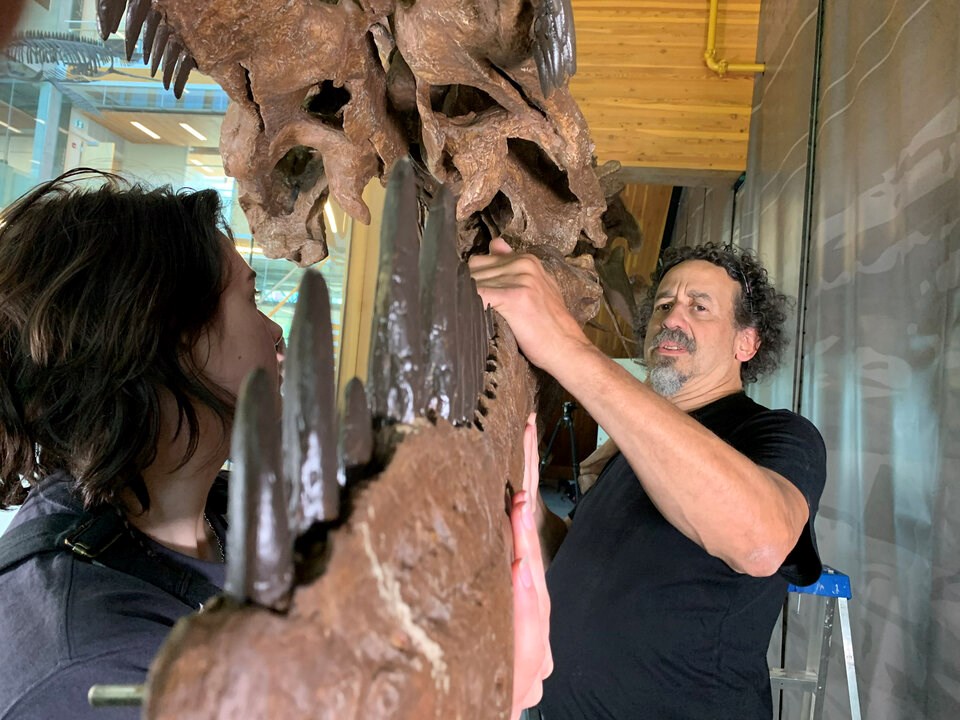Near the western edge of Metro Vancouver, a five-tonne ancestor of the Tyrannosaurus rex snaps at the tail of a scavenger looking to get a piece of its kill.
Assembled from more than 150 pieces Tuesday, the fossil casts of the 30-foot-long Daspletosaurus Torosus joins a smaller two-metre-long raptor, the Dromaeosaurus Albertensis, in a new exhibit at University of British Columbia’s Pacific Museum of Earth.
Dubbed ‘Life at the Edge,’ the exhibit aims to give visitors a peek into deep time, and bring them closer to the often imperceptible processes that transform the planet’s geology, atmosphere and oceans over millions of years.
“It is trying to capture the real magnitude of time and life on our planet,” said Oli Beeby Maglaque, one of a two-person team who designed the exhibit.
“The dinosaurs lived millions and millions of years longer than we have existed on this planet. And that's extremely hard to conceptualize because we only really experience our own lives.”
When finished, the scene will be set under an otherworldly light at the end of the Cretaceous period, about 76 million years ago.
At the time, was pumping large amounts of greenhouse gases into the atmosphere. The planet began to cool, and many specialized species had already started on a long road to extinction, some scientists think.
That road came to an abrupt end about 66 million years ago, when in an instant, a 10-kilometre-wide asteroid slammed into Mexico's Yucatan Peninsula.
The impact vaulted a massive plume of vapour, dust and ash into the atmosphere. As it circled Earth, those particles blocked out the sun. At sea, tsunamis echoed across the globe as the oceans faced shock acidification, according to one 2019 . On land, plants struggled to photosynthesize, and one by one up the food chain, life started to collapse.
Millions of years of evolution had given rise to the dinosaurs, and in an instant, their dominance was wiped out along with 75 per cent of all species on the planet.
On Thursday, Rod Bartlett puzzled his way through a small piece of the evolutionary puzzle that led up to that catastrophic moment. Bartlett is one of only two people in sa国际传媒 who puts together dinosaur bones and their moulded analogues. He says the decades he has spent assembling ancient creatures has taught him to thread the needle between certainty and educated guesses.
Nearly a third of the hundreds of pieces of Daspletosaurus Torosus bone scattered over the floor of the UBC museum Tuesday afternoon were found in near the Judith River in Montana — once a swampy coastal area next to a shallow inland sea. The rest was sculpted or sourced from other skeletons, says Bartlett. The smaller but more common Dromaeosaur, a raptor the size of six-foot-long wolf, came from Dinosaur Provincial Park in Alberta.

A resident of North Vancouver who never had any formal training in palaeontology, Bartlett has helped prepare, repair and install fossils since the mid-1990s, in a career he attributes to being in the right place at the right time, and always wanting to learn more.
In 1993, Bartlett co-founded the Vancouver Paleontological Society, and despite working contracting jobs on the side, he’s kept at it ever since. Technology has made the plodding work of assembling dinosaur bones slightly easier in recent years. Before the fossils arrived in Vancouver, the group that prepared them sent Bartlett a video of how to assemble the fibreglass and metal casts.
“It’s advantageous because it tells me which size Allen keys to use where. I’ve made a little schematic telling me that,” he said.
Bartlett says that by focusing on the bones, you start to see a bigger picture of ancient life.
Take Tyrannosaurs, a species whose the teeth are each about the size of a small banana. Some dinosaur predators, like the Allosaurus, had a tooth like a steak knife, the serrated edge going up one side of it, said Bartlett. But the Tyrannosaur had a tooth whose serrated edge ran up one side and came down another.
“When it bit into you, it would twist your flesh open. That would be really nasty,” said Bartlett.
And unlike some of its contemporaries, the Tyrannosaur’s three toes were fused together at its ankle, making it harder to articulate but also harder to twist as it darted in different directions.
It’s not clear which if any of those details sunk in with a crowd of children looking on, faces pressed against protective glass — first with wonder, then impatience — as Bartlett hung a toothy jaw bone on a massive skull. It's an understandable sense of restlessness, and one that inspired the exhibit in the first place, said Beeby Maglaque.
“It's looking at what it's like to live at the edge of a major extinction event, at a critical turning point in deep time in Earth's history,” said Beeby Maglaque. “We are also living at a moment that is a critical turning point for Earth as a planet, or life on Earth, because of the crisis and threat we face from climate change.
“But we have agency in a way that, of course, the dinosaurs didn’t.”

